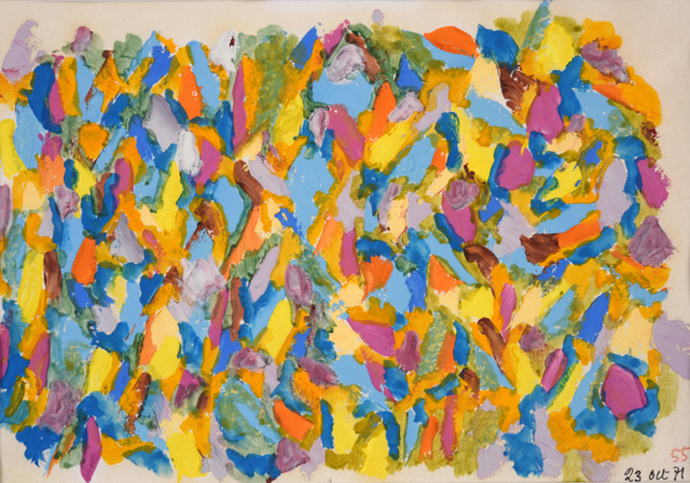
Untitled, watercolor by Roland Barthes, 1915-1980
ハイデガーにおけるケア概念
Heidegger's Concept of Care

Untitled, watercolor by Roland Barthes, 1915-1980
「「生」という語とその用法とが暖昧多義で混乱をき たしているからといって、簡単にこの語を使うのをやめてしまえばよいということにはならない。この語にはとにかくさまざまな意味方向が備わっているのであ り、それらを追跡してこそそういった各種の用法によって意味される対象性へと突き進みえようはずが、やめてしまえばその可能性も放棄してしまうことにな る」(p.18)。
「この術語(=「生」引用者)の多義性は、それが指 している対象そのものに根差しているのであろう。語意が曖昧であるのは、哲学にとっては、その暖昧さを取り除く機縁であるか、あるいはかりにその曖昧さが 対象そのものに根差す必然的なものであるなら、その曖昧さを明確に体得された、見通しのきいた曖昧さへと転換する機縁よりほかのものではありえない。多義 性(【ギリシャ語】〔さまざまに語られること〕)に服するとは、単に個々の孤立した語意をつつきまわすことではなく、その語が意味する対象性そのものを納 得のいくものにし、さまざまの異なった語意が出てくる動機の源泉を見きわめようとする徹底的な態度の表現にほかならない」(p.19)。
「事実的な生の動性の根本意味は気遣うこと (sorgen, curare)である。一定の仕方で方向づけられ気遣いながら「何かを期しつつある存在」、この中には、その生の気遣いの期するところ、すなわちその都度 の世界が現に在る。気遣うという動性には、事実的な生が自分の世界と関わり合うという性格が備わっている。気遣いの期するところとは、この関わり合いの相 方(Wormit des Umgangs)である。世界の現実存在、現存在の意味は、世界が、気遣いながら関わり合うことの相方であるという性格に基づいており、またその性格に よって規定されている。世界はすでにつねに何らかの仕方で気遣いの中に取り込まれ(据えられ)ているものとしてそこに現に在る。世界は、気遣いがどちらの 方向に向かうかに応じて、まわりの世界、共同世界、自己世界と分節してゆく。それに対応して、気遣いのほうも、やりくりのうえでの気遣い、職業上、娯楽上 の気遣いや、邪魔されたくない、死ぬまい、何々についてよく通じたい、何々に関して知りたいといった気遣いでもあり、また安心立命を得たいという気遣いな どでもある」(p.20)
「配慮的に気遣う(Besorgen)という動性 は、それがどう遂行されるか、関わり合う相方として何に関わってゆくのかという点で実に多様であり、何々に取りかかるとか、何々を用意する何々を製作す る、何々を通じて確かめる、何々を利用する、何々に転用する、何々を取得する、保存する、失ってしまう、といった具合にさまざまな様態を示す。その際これ ら様態のそにおいて用務を果たすうえでの関わり合いの相方は、その都度、一定の仕方で知られ親しまれいる。気遣いながら関わり合うことは、その相方をつね にある一定の仕方で見ている。この関わり合いの中で活躍し、これを時熟させるひとつの要因としてこの関わり合いを牽引しているのが、目配り (Umsicht)である。気遣うとは自分のまわりに目を配ることであり、目配りするものであるかぎりにおいて同時にこの目配りを養おう、関わり合う対象 との親しさを維持保全し増大させようと気を遣っている」(Pp.20-22)。
| Care Care is synonymous with Dasein because Being-in-the-world belongs essentially to Dasein. In actual fact, this is what is meant by the meaning of Being conceived of as "I reside alongside"--see Being (the formal understanding of). Dasein's Being is always looking out towards the world is therefore is essentially manifested in care and concern. And also the ontological conception of Being-in as the "alongsidedness of things," suggests both their close proximity to Dasein, and also their intimate intertwining with Dasein. In making the Being of Dasein visible as care, care itself must be taken as an ontological structural concept. In this sense, care has nothing to do with its everyday significations of "trials and tribulations", or "being bound up in the 'cares of life'." Although, it is true that ontically we can come across these aspects of care in every Dasein. And, like the opposite state of 'gaiety'-- which in its true signification means 'a freedom from care'--they are only possible because Dasein is synonymous with care when understood ontologically. [ref. ¶ 12, page 84] |
ケア ケアはダーザイン(現存在)と同義である。なぜなら、世界における存在は本質的にダーザインに属するものだからである。実際のところ、これは「私が傍らに 存在する」--「存在(の形式的理解)」を参照--として考えられている存在の意味が意味するところである。ダーザインの「存在」はつねに世界を見つめて おり、それゆえ本質的に「配慮」と「関心」のうちに現れているのである。そしてまた、「事物の並存」としてのビーイングの存在論的概念は、それらがダーザ インに近接していると同時に、ダーザインと親密に絡み合っていることを示唆している。 ダーザインのビーイング(存在)をケアとして可視化する際、ケアそのものを存在論的構造概念としてとらえなければならない。この意味において、ケアは「試 練や苦難」や「『人生の悩み』に縛られる」といった日常的な意味合いとは無関係である。とはいえ、存在論的には、あらゆるダーザインにおいて、ケアのこう した側面に出くわすことができるのは事実である。そして、その反対の状態である「陽気」--その真の意味において「気遣いからの解放」を意味する--のよ うに、それらは、存在論的に理解されるとき、ダーザインが気遣いと同義であるからこそ可能なのである。[参考文献¶12、84ページ]。 |
| Dasein Dasein is one of the core terms in Being and Time. It can be simply defined as entity that is conscious of the meaning of its own existence. In practical terms, this means the human being is Dasein, since, arguably, no other life-forms on the planet are conscous of thier own existence. For example, it is argued that no other animals buries their dead. Here are some passages which illustrate how Heidegger's utilises the concept of Dasein. To work out the question of Being adequately, we must make an entity—the inquirer—transparent in his own Being. Thus in the very act of asking of the question, "What is Being?" this inquirery becomes Dasein's mode of Being. Dasein therefore gets its essential character from what is inquired about-—namely, Being. [ref. ¶ 2, page 27] The meaning of Being, which human beings themselves possess, we call "Dasein". This means that Dasein alone has a special distinctiveness as compared with other entities. Provisionally we can say that Dasein's concern with its own Being is an issue for it. This implies that Dasein's relationship to its own being is constitutive for the definition of Being per se. [ref. ¶ 4, page 32] The Fundamental ontology must be sought in the existential analytic of Dasein, because it is the source of all other ontologies. [ref. ¶ 4, page 34] This means that the human being itself is the ground upon which all other notions of the world and the existence of things stand. This implies that there is no objectivity nor subjectivity, and no cleaving of existence into interior (mental) categories and exterior (physical) categories, since the world and Dasein are only perceived and perceivable through Dasein's own awareness of its Being. Dasein is, of course, close to us, in the sense that our "Being" and our notion of ourselves are the same thing. But but this is also a paradox, since Dasein is simultaneously also the thing which is farthest away. The fact that Dasein is onto-ontologically prior (to its own thoughts about itself), means that Dasein's own structure of Being is effectively concealed; hidden from view. But, when we speak of it in terms of a pre-ontological understanding, Dasein is hardly a stranger to us. [ref. ¶ 5, page 36 - 37] The interpretation of Being has peculiar difficulties, which can basically be put down to the fact that we are the object of our own inquiry. When we consider ourselves as entities under examination, our behaviour changes, and thus the nature of the object we are looking at also changes. [ref. ¶ 5, page 37] |
ダーザイン(現存在) ダーザイン(現存在)は、『存在と時間』の中核をなす用語のひとつである。簡単に定義すれば、自らの存在の意味を意識している存在である。実際的な言い方 をすれば、これは人間がダーザイン(現存在)であることを意味している。例えば、死者を埋葬する動物は他にはいない。以下は、ハイデガーがダーザインの概 念をどのように活用しているかを示すいくつかの文章である。 存在についての問いを適切に解決するためには、われわれはある存在(問う者)を彼自身の存在において透明にしなければならない。したがって、「存在とは何 か」という問いを立てる行為そのものが、ダーザイン(現存在)の存在様式となる。したがってダーザイン(現存在)は、その本質的な性格を、問いかけられる もの--すなわち「存在」--から得るのである。[参照¶2、27ページ]。 人間自身が持っている存在の意味を、私たちは「ダーザイン(現存在)」と呼ぶ。これは、ダーザイン(現存在)だけが、他の存在と比較して特別な識別性を 持っていることを意味する。暫定的に言えば、ダーザイン(現存在)にとっては、それ自身の存在に対する関心が問題なのである。このことは、ダーザイン(現 存在)とそれ自身の関係が、存在それ自体の定義にとって構成的であることを意味する。[参照¶4、32ページ]。 根源的存在論はダーザイン(現存在)の実存的分析に求められなければならないが、それは他のすべての存在論の源泉だからである。[このことは、人間そのも のが、世界と事物の存在に関する他のすべての概念の基礎となっていることを意味する。なぜなら、世界とダーザインは、ダーザイン(現存在)自身の存在意識 を通してのみ知覚され、認識可能だからである。 ダーザイン(現存在)はもちろん、私たちの「存在」と私たち自身の概念が同じものであるという意味で、私たちに近い存在である。しかし、ダーザイン(現存 在)は同時に最も遠い存在でもあるのだから、これはパラドックスでもある。ダーザイン(現存在)が存在論的に先行しているという事実は、ダーザイン(現存 在)自身の「存在」の構造が事実上隠されていることを意味する。しかし、前存在論的理解という観点からそれを語るとき、ダーザイン(現存在)は私たちに とってほとんど見知らぬ存在ではない。[参照¶5、36-37ページ]。 存在の解釈には独特の困難があるが、それは基本的に、われわれがわれわれ自身の探求の対象であるという事実に帰することができる。私たちが自分自身を調査 対象の実体として考えるとき、私たちの行動は変化し、したがって私たちが見ている対象の性質も変化する。[参照¶5、37ページ]。 |
| http://www.visual-memory.co.uk/b_resources/b_and_t_glossary.html |
リンク
文献
その他の情報
Copyleft, CC, Mitzub'ixi Quq Chi'j, 1996-2099